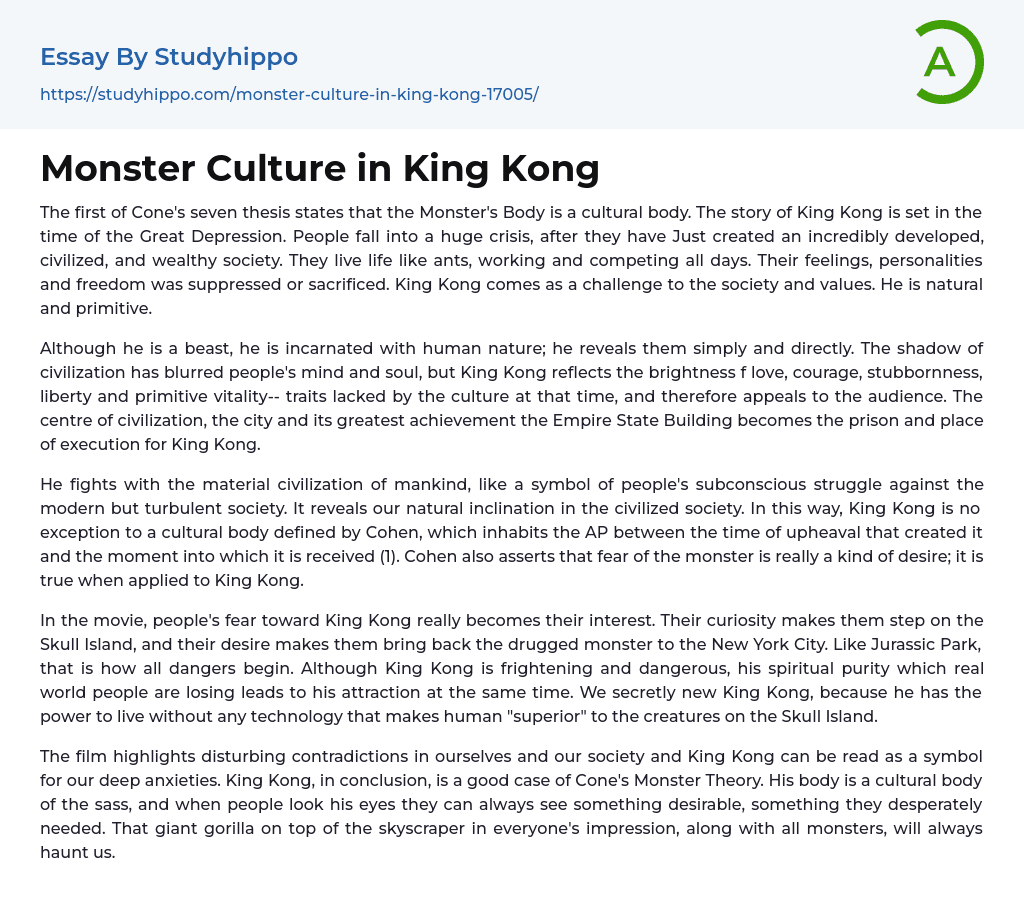The first of Cone's seven thesis states that the Monster's Body is a cultural body. The story of King Kong is set in the time of the Great Depression. People fall into a huge crisis, after they have Just created an incredibly developed, civilized, and wealthy society. They live life like ants, working and competing all days. Their feelings, personalities and freedom was suppressed or sacrificed. King Kong comes as a challenge to the society and values. He is natural and primitive.
Although he is a beast, he is incarnated with human nature; he reveals them simply and directly. The shadow of civilization has blurred people's mind and soul, but King Kong reflects the brightness f love, courage, stubbornness, liberty and primitive vitality-- traits lacked by the culture at that time, and therefore appeals to the au
...dience. The centre of civilization, the city and its greatest achievement the Empire State Building becomes the prison and place of execution for King Kong.
He fights with the material civilization of mankind, like a symbol of people's subconscious struggle against the modern but turbulent society. It reveals our natural inclination in the civilized society. In this way, King Kong is no exception to a cultural body defined by Cohen, which inhabits the AP between the time of upheaval that created it and the moment into which it is received (1). Cohen also asserts that fear of the monster is really a kind of desire; it is true when applied to King Kong.
In the movie, people's fear toward King Kong really becomes their interest. Their curiosity makes them step on the Skull Island, and their desire make
them bring back the drugged monster to the New York City. Like Jurassic Park, that is how all dangers begin. Although King Kong is frightening and dangerous, his spiritual purity which real world people are losing leads to his attraction at the same time. We secretly new King Kong, because he has the power to live without any technology that makes human "superior" to the creatures on the Skull Island.
The film highlights disturbing contradictions in ourselves and our society and King Kong can be read as a symbol for our deep anxieties. King Kong, in conclusion, is a good case of Cone's Monster Theory. His body is a cultural body of the sass, and when people look his eyes they can always see something desirable, something they desperately needed. That giant gorilla on top of the skyscraper in everyone's impression, along with all monsters, will always haunt us.
- 1920S essays
- 1950S essays
- 1960S essays
- 19Th Century essays
- 20Th Century essays
- Ancient Greece essays
- Bravery essays
- British Empire essays
- Civilization essays
- Colonialism essays
- Declaration of Independence essays
- Evidence essays
- Genocide essays
- Gilded Age essays
- Historical Figures essays
- Historiography essays
- History of the United States essays
- Letter from Birmingham Jail essays
- Louisiana Purchase essays
- Nazi Germany essays
- Rebellion essays
- Revolution essays
- Roman Empire essays
- Russian Empire essays
- The Columbian Exchange essays
- Vikings essays
- War essays
- What is History essays
- World History essays
- World Hunger essays
- Ambition essays
- Anger essays
- Betrayal essays
- Boredom essays
- Confidence essays
- Courage essays
- Desire essays
- Disgrace essays
- Doubt essays
- Empathy essays
- Fairness essays
- Fear essays
- Feeling essays
- Forgiveness essays
- Grief essays
- Guilt essays
- Happiness essays
- Harmony essays
- Hate essays
- Honesty essays




